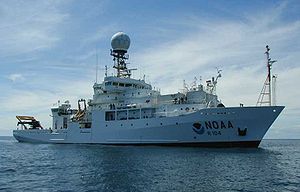NOAAS Ronald H. Brown

| |
| History | |
|---|---|
| Name | NOAAS Ronald H. Brown |
| Namesake | Ronald H. Brown (1941–1996), U.S. Secretary of Commerce (1993–1996) |
| Operator | NOAA |
| Builder | Halter Marine, Pascagoula |
| Laid down | February 1995 |
| Launched | May 30, 1996 |
| Completed | April 25, 1997 |
| Homeport | Charleston, South Carolina |
| Identification |
|
| Status | Active NOAA fleet |
| General characteristics | |
| Tonnage | 3,180 gt; 1,332 dwt |
| Displacement | 3,250 tons |
| Length | 274 ft (84 m) |
| Beam | 52.5 ft (16.0 m) |
| Draft | 17.0 ft (5.2 m) |
| Propulsion |
|
| Speed | 15 knots max; 12 knots (22 km/h) cruise |
| Capacity | 32 passengers |
| Crew | 6 officers + 20 crew |
NOAAS Ronald H. Brown (R 104) is a
The ship is named for United States Secretary of Commerce Ron Brown, who was killed while in office in a plane crash on 3 April 1996 while on a trade mission to Bosnia and Herzegovina.[2]
Construction and commissioning
Ronald H. Brown′s
Technical characteristics
At 274 feet (84 m) in length, Ronald H. Brown is the largest vessel in the
The deck equipment features three winches, two fixed cranes, a portable crane, a hydrographic boom, and an A-frame. This equipment gives Ronald H. Brown a lifting capacity of up to 42,000 pounds (19,000 kg) as well as up to 10,000 metres (33,000 ft) of cable that can pull up to 8,100 pounds (3,700 kg). One of the winches is specifically for use with specialty cables such as optical fiber cables or coaxial EM Cable.
As a research vessel, a substantial amount of the ship is dedicated to laboratories. Included in the 4,100 square feet (380 m2) of laboratory space are a
In addition to her state-of-the-art oceanographic sampling capabilities, the Ronald H. Brown has instrumentation to study the
Ronald H. Brown and three other research ships were all built to the same basic design. Her three
Operational history
This section needs expansion. You can help by adding to it. (August 2018) |
Ronald H. Brown has participated in many national and international projects.[4]
On 18 July 2013, Ronald H. Brown departed Charleston;
See also
- NOAA ships and aircraft
References
- ^ Federal Oceanographic Fleet Status Report May 2013
- ^ "Marine Operations - Office of Marine and Aviation Operations". www.moc.noaa.gov. Archived from the original on 28 April 2006. Retrieved 19 July 2017.
- ^ a b c NOAA Ship Characteristics and Capabilities – Updated 12/6/2013
- ^ a b "Project Archives". NOAA Ship Ronald H. Brown. February 10, 2004. Archived from the original on May 2, 2006. Retrieved May 9, 2006.
- ^ a b c d Hall, David, "NOAA research ship returns to Charleston home port after worldwide deployment," noaa.gov, March 27, 2017 Retrieved August 21, 2018
External links
- "NOAA Ship Ronald H. Brown". April 15, 2004. Archived from the original on July 31, 2010.
